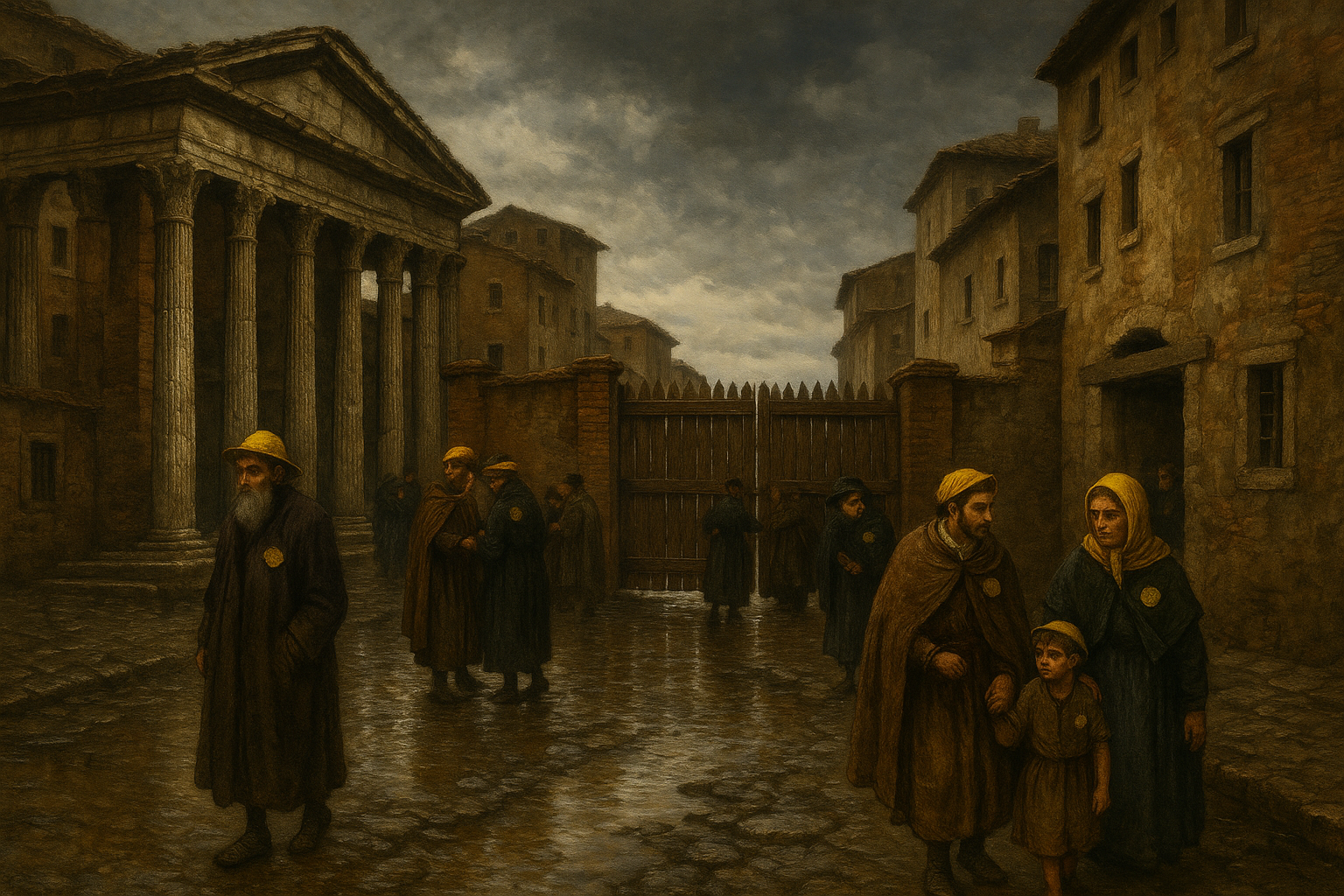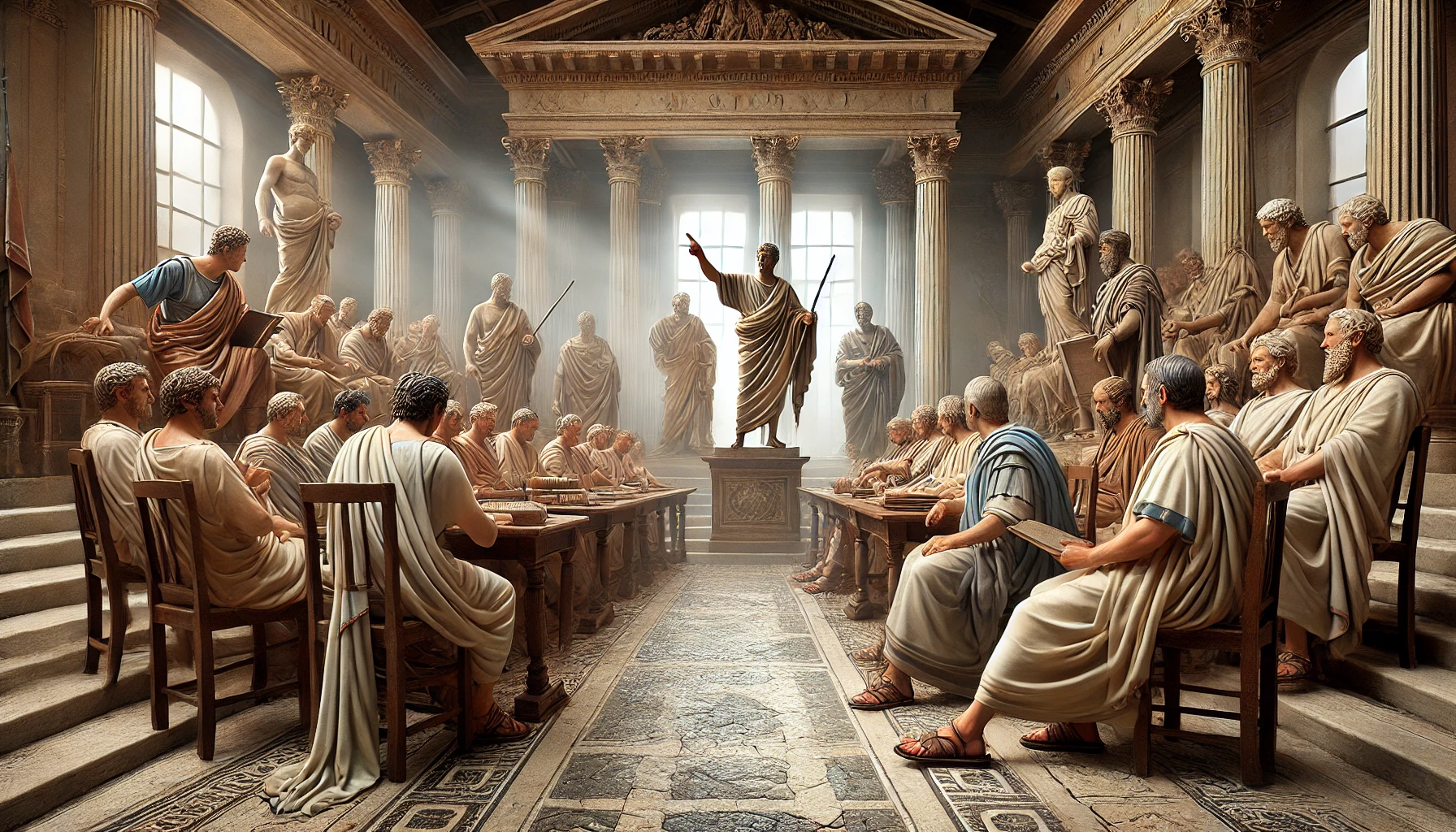A decree that redrew the city
On 14 July 1555 Pope Paul IV issued the bull Cum nimis absurdum, which ordered the segregation of Rome’s Jews inside a walled quarter along the Tiber near the Portico of Octavia. The measure was framed as a correction of civic disorder, yet its practical effects were urban and social engineering. Locked gates, curfews, and distinctive clothing rules turned a long present minority into a bounded population, visible in dress and constrained in movement. The new quarter stood in a low-lying, unhealthy zone that the river flooded often. Location, masonry, and statute combined to mark difference in stone and water.
Where the walls rose and why that site mattered
The quarter stretched around today’s Via del Portico d’Ottavia and Piazza delle Cinque Scole, between the Theatre of Marcellus and the river. This was an old commercial district, layered with ancient monuments and crowded housing. Selecting a site already dense and flood prone was not accidental. It reduced expansion, kept the authorities’ surveillance easy, and, by proximity to markets, tied the community to regulated trades. Gates locked at night restricted exit and entry. The streets within were narrow, the built fabric vertical, and light scarce. Even when rules flexed under later pontificates, the spatial memory of exclusion endured.
Rules that touched clothing, craft, and prayer
The bull required visible signs on clothing, with yellow items for men and women, and imposed attendance at sermons intended to convert. It barred Jewish physicians from treating Christians, pushed Jewish merchants toward secondhand goods, and hemmed in moneylending while favoring Christian pawn banks. The synagogue complex was limited to a single building housing multiple congregations under one roof, later known as the Five Scole. All these measures aimed to compress economic horizons and channel worship into a supervised space. The ghetto was a legal boundary that reached into closets, shops, and pulpits.
Floods as a policy tool and a daily risk
Tiber floods were a constant. Streets turned to channels, shops closed, and food and fuel prices rose. Families moved belongings to upper floors and waited for the water to fall. Because the city did not embank the river until the late nineteenth century, flooding functioned as a pressure that reinforced poverty. It also generated community routines of care, from drying ritual textiles to repairing prayer books. The river’s behavior shaped liturgical calendars too, since reopening a synagogue after inundation required cleaning, inspection, and the replacement of damaged furnishings.
Markets, craft, and the limits of livelihood
Within the walls, work gravitated to trades that survived regulation: secondhand textiles, small loans, wholesale of scrap metals and used tools, food retail, and catering associated with feast days. Restrictions on guild membership and medical practice closed profitable paths. Yet the community developed networks of credit and trust that made small businesses viable. Women’s labor mattered, from mending clothing to preparing kosher food for sale. Fiscal fines and rents, however, kept margins tight. When the authorities raised levies or enforced bans more strictly, households slid quickly from modest security to precariousness.
The Five Scole and a culture of resilience
The limitation to a single synagogue building did not erase diversity. The Five Scole housed distinct rites under one roof: Italian, Catalan, Castilian, Sicilian, and sometimes other traditions depending on the period. The building’s interior carried the memory of diasporas layered onto an ancient city. Festivals brought the quarter into the streets, with processions that turned narrow lanes into corridors of sound and scent. Charity organizations supported the poor, provided dowries, and maintained schools. Manuscripts and ritual objects circulated as a shared treasury of memory, even when damp and dust were constant threats.
Surveillance and attempts at conversion
Compulsory sermons at specified churches formed part of the legal package. Attendance was monitored, and feast days drew special scrutiny. Popular polemics flared during Holy Week, when authorities tightened watch to deter insults and violence. Many conversions recorded in registers came from poverty, mixed marriages, or pressure rather than persuasion. Yet even in a climate of surveillance, Jewish learning persisted, with rabbis writing responsa that navigated both halakhic duty and papal law. The rhythm of study became a quiet resistance that helped preserve continuity.
Moments of loosening and return
The late sixteenth and seventeenth centuries saw alternating severity and leniency as different pontiffs emphasized control or stability. In the revolutionary era of the 1790s, French occupation briefly opened the gates. Restoration governments reversed the change, though the strength of the old system varied by year. In 1848 some restrictions eased in Italian territories, but Rome’s regime remained cautious. The turning point came in September 1870, when the Kingdom of Italy annexed Rome. Civil equality followed and the ghetto system ended. In 1888 the walls came down as a modern town plan reshaped the riverside.
A new landmark and the politics of memory
With emancipation secure, community leaders chose to build a new synagogue on the former ghetto site. The Great Synagogue, inaugurated in 1904, rose above the riverbank with a distinctive profile and a large square dome. It asserted presence and dignity where gates had once shut. Inside, the preserved fittings and textiles from the old Five Scole became the core of a museum collection that records the long years within walls. Urban embankments also transformed the area, taming floods that had once defined daily life. Stone that once excluded now frames remembrance.
What changed and what persisted
Abolition ended legal segregation and opened education, medicine, and public service to Jewish Romans. Yet social habits formed under the old regime faded slowly. Migrants from the former quarter carried its bonds into new neighborhoods, and businesses that began under regulation adapted to new markets. The memory of the ghetto became part of Rome’s civic story, a caution about how law can shape space and how space can train expectations. Visitors today walk from ancient porticoes to twentieth century stone within a few hundred meters and encounter, in that short distance, the measure of four centuries.
FAQ
Where exactly was the Roman Ghetto and why was it chosen?
The quarter occupied the low ground around today’s Via del Portico d’Ottavia and Piazza delle Cinque Scole, between the Theatre of Marcellus and the Tiber. Authorities selected an already dense and flood prone zone that limited growth and simplified surveillance. The location near markets tied residents to regulated trades while keeping the quarter close to the city center yet clearly bounded. Choosing this site turned topography into policy and made river risk part of daily life for thousands of people.
What did the 1555 bull require from Jewish residents?
The bull mandated residence inside a walled and gated area that was locked at night. It required visible markers on clothing, imposed attendance at conversionist sermons, curtailed professions such as medicine for Christian patients, and restricted trade to lower margin activities like dealing in used goods. It also limited the synagogue complex to a single building housing multiple congregations. These provisions aimed to compress civic presence, narrow economic opportunity, and keep worship under close oversight.
How did Tiber floods affect life inside the quarter?
Floods entered homes and shops regularly because the river lacked embankments until the late nineteenth century. Families lifted belongings to higher floors, community officials protected ritual objects, and trade paused while water receded. Damp and silt damaged books and textiles, so cleaning and repair were routine. Prices for basic goods rose during long inundations, and the poorest households suffered first. Flooding was not only a natural hazard. It functioned as a structural pressure that reinforced the hardships created by legal segregation.
When did the ghetto end and what replaced it?
Legal segregation effectively ended after the annexation of Rome by the Kingdom of Italy in 1870. The walls were removed in 1888 as part of a modern town plan. In their place, the community built the Great Synagogue, inaugurated in 1904 on the former ghetto site. The new building, together with the Jewish Museum’s collections from the old Five Scole, turned an area once defined by confinement into a landscape of visibility, worship, and public memory.
What remains visible today for visitors?
Visitors can trace the outline of the former quarter around the Portico of Octavia and the Theatre of Marcellus, walk the streets of Via del Portico d’Ottavia, and visit the Great Synagogue and the Jewish Museum. Although the nineteenth century embankments and new construction altered the fabric, the juxtaposition of ancient porticoes, early modern lanes, and the twentieth century synagogue allows a close reading of four centuries of change within a compact urban space.






